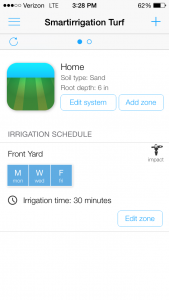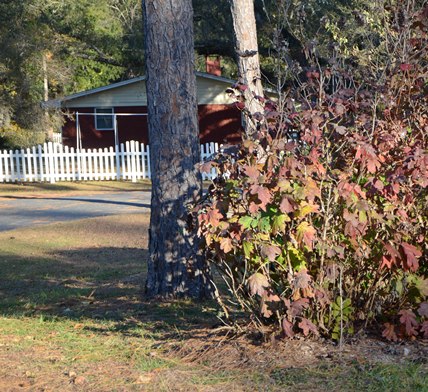
by Les Harrison | Nov 18, 2014

Even though the lawn and landscape are going dormant, there is much which can be done now to prepare for Spring 2015.
Even though it is not officially winter and the landscape is becoming dormant. With the exception of live oak trees, all the plants and trees which lose their leaves are now dropping them to the ground.
For the north Florida homeowners consumed with plans for the holidays, late November is a tempting time to let the landscape take care of itself during this winter’s nap.
This is not necessarily the best plan. There are plenty of task to handle which will make the upcoming growing season more productive and easier.
First on the list of winter’s lawn and garden task is taking a soil sample. It is simple, inexpensive, and efficient from both an economic and environmental standpoint.
Stop by the local UF/IFAS County Extension Office to pick up a free kit which is used to mail the samples, with a processing fee, to the UF Soil Test Lab. The report is usually returned in under two weeks.
Depending on the analysis chosen, the report will deliver the samples soil pH, or the nutrients needed and the soil pH. This is useful information for the spring and summer growing season, and during winter’s dormant period.
People with wood burning fireplaces should be particularly aware of the soil pH which is a measure of acidy or alkalinity. The pH range helps determine the potential success of plants, vegetables and shrubs which will grow in the sampled soil.
Fireplace ash is alkaline and an excellent soil amendment, if the soil pH is too low. However, if the soil pH is too high, then the fireplace ash only aggravates the existing problem of growing desirable plants and grasses.
Many Florida soils tend to have a high concentration of phosphate, an important and useful plant nutrient in the right quantities. Having a soil analysis early which identifies the amount of phosphate available in the land gives the homeowner or garden manager plenty of time to locate a source of blend-fertilizer with the correct amount of phosphate.
The second task on the list is to manage the leaves, mulch and thatch. Each has the potential to be an asset to the landscape, or a hazard.
Leaves should be raked up before they have the time to smother the grass. A carpet of leaves in the yard may appear very seasonal, but usually work against the objective of those who ultimately want a green grassy yard.
As leaves decompose, they leach acidic nutrient into the soil. This is especially true of oak leaves and pine needles.
Another issue is leaf litter and thatch, produced from grass clippings, which will provide an ideal breeding ground for fungi and diseases. The cool, moist recesses common to thatch will incubate any number of problems which will appear in the spring to ruin the perfect yard.
Rake the leaves and use in flower beds or compost heaps. The shrubs will overwinter better with the leaf insulation which keeps the root zone at the correct moisture level and provides desirable nutrients to the plants.
Dethatch lawn mechanically to remove excess debris. Use the excess organic material as mulch or in a compost pile.
The landscape will show its appreciation by returning in a healthy and strong condition in Spring 2015.
To learn more about winter landscapes visit the nearest UF/IFAS County Extension Office. Additional information will be found in the Florida Lawn Handbook
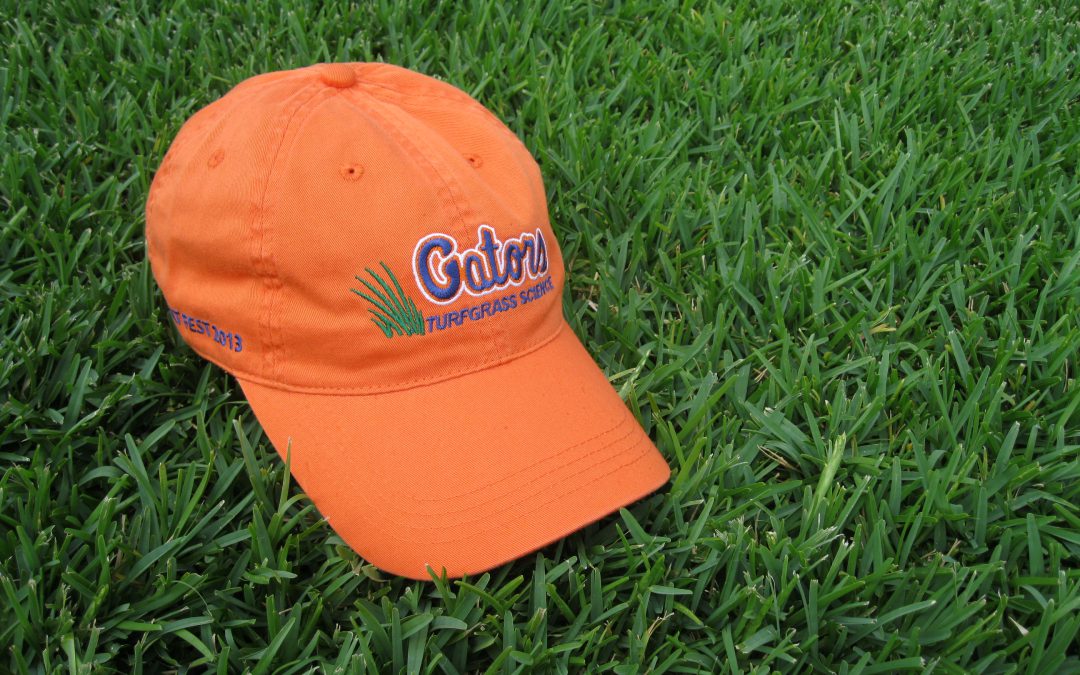
by Mary Salinas | Sep 16, 2014
Many of us have a tendency to want to spoil those we care for – our significant other, our pets, our children, even our lawns. Some homeowners who long to have a lush, green, healthy lawn tend to spoil their lawns with lots of water. Their lawns should not suffer through a dry, thirsty day! However, spoiling a lawn with too much water can literally be killing it with kindness. (Keep in mind that we are discussing established turf, not newly installed lawns; new lawns do need special care.)
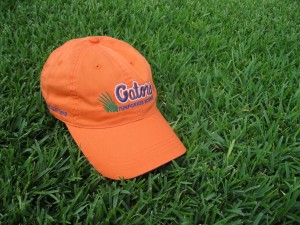 Turfgrass that is overwatered can suffer several fates. Roots can stay shallow near the surface and not dig deep into the soil as they should. A deep root system allows the turf to be more resistant to stress from drought, disease and abiotic factors such as wear from traffic. Excessive water leads to excessive lush growth – that may sound like a good thing, but it’s not. Excessive lush growth leads to thatch build-up and it creates a perfect environment for pests and diseases. An abundance of water also assists those nasty weed seeds to germinate and compete with your turfgrass.
Turfgrass that is overwatered can suffer several fates. Roots can stay shallow near the surface and not dig deep into the soil as they should. A deep root system allows the turf to be more resistant to stress from drought, disease and abiotic factors such as wear from traffic. Excessive water leads to excessive lush growth – that may sound like a good thing, but it’s not. Excessive lush growth leads to thatch build-up and it creates a perfect environment for pests and diseases. An abundance of water also assists those nasty weed seeds to germinate and compete with your turfgrass.
So how do you know how much irrigation is best for the health of your lawn? That depends on the temperature, time of year, the type of turf and your soil type. Irrigate just enough to get water to the root zone without leaching beond that zone. Usually, that amount is 1/2″ to 3/4″ of water each time you irrigate. How often, then, do you turn on those sprinklers?
Let your lawn get thirsty before you water. University of Florida research shows that lawns that dry out and start to show a little drought stress before getting more water actually perform better in the long run. So wait until the leaf blades start to fold, the blades start to look a bit off-color, or you can start to see footprints where you’ve walked.
For lots of great information and publications on caring for your lawn, consult the Your Florida lawn website.
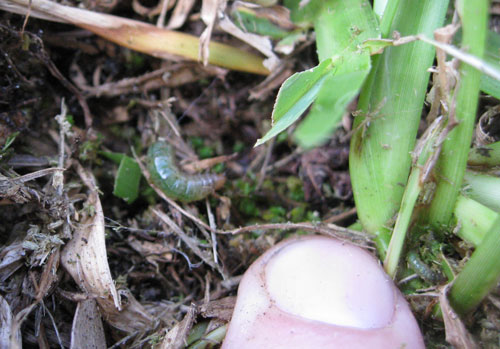
by Taylor Vandiver | Sep 9, 2014
What’s eating my lawn? Does your grass look ragged in areas, as if someone randomly used a weed-eater here and there? Are you noticing brown patches that have a closely clipped appearance compared to other areas of your lawn? Your turf may be playing host to Tropical Sod Webworm.
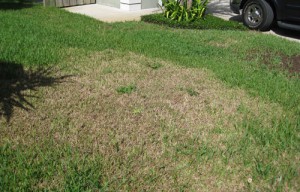
Sod webworm damage in a home lawn. Photo courtesy UF/IFAS.
Sod webworm damage is subtle at first. You have to look closely to notice larval feeding damage. However, an easy indication of their presence is the light tan/brown colored moths, which are the adult stage of the pest. You may see them fly up as you walk through your lawn or if you disturb a nearby bush. The moths do not cause any damage to the turf, but they are depositing eggs, which will result in their offspring, the caterpillars, who do all the chewing damage.
The larvae are gray-green and have spots on each segment. The mature larvae can be up to 1 inch in length. Larvae will curl up in the soil during the day and feed at night. So if you happen to notice caterpillars feeding during the day, it’s probably not sod webworm. You will notice chewed notches along the leaf blade, holes in the leaf and even leaf blade skeletonizing. The older the larvae are, the more they will eat. Damage may start out as a ragged appearance in your turf, which can be hard to diagnose. However, if left unchecked, sod webworm can cause considerable injury to your lawn.
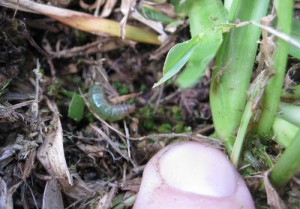
Sod webworm larvae. Photo courtesy UF/IFAS.
If you are uncertain of their presence you can always use a soap drench to flush out larvae. Mix 2 tablespoons of dish soap with 2 gallons of water and pour it over a damaged area (about 3 square ft.). The soap mixture will irritate the pest and bring them to the surface so you can easily identify them. If nothing appears in the area tested move to another damaged site and try again. Here is a link to a video that will give more information on identifying Tropical Sod Webworm.
Tropical Sod Webworm is considered a pest of all warm-season turfgrasses. However, St. Augustinegrass is most commonly affected. The best way to prevent a pest infestation is to use proper cultural maintenance practices for your lawn type. However, if the pest does appear, chemical control should be targeting the larvae stage of the pest. There are multiple products marketed to control lawn caterpillars. However, you may want to consider using B.t. (Bacillus thurengiensis), which is a bacterium that will only harm caterpillars and not bother beneficial insects that may be in your lawn. For more information you can contact your local extension office.
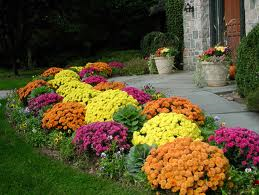
by Larry Williams | Sep 9, 2014
The Emerald Coast Home Show, Health Fair and Business Expo will include lawn and landscape seminars and an information booth hosted by the Okaloosa County Master Gardeners. This event will take place September 13 and 14 at the Emerald Coast Convention Center, 1250 Miracle Strip Parkway in Fort Walton Beach. The horticulture seminars will be provided by the UF/IFAS Extension Office in Okaloosa County.
 A feature of the Emerald Coast Home Show Health Fair and Business Expo will be an information booth hosted by the Okaloosa County Master Gardeners. Master Gardeners will be on hand to answer your gardening questions and to distribute information pertinent to gardening and lawn care on the Gulf Coast.
A feature of the Emerald Coast Home Show Health Fair and Business Expo will be an information booth hosted by the Okaloosa County Master Gardeners. Master Gardeners will be on hand to answer your gardening questions and to distribute information pertinent to gardening and lawn care on the Gulf Coast.
In addition to an information booth hosted by Master Gardeners, free educational seminars will be provided. On Sunday, September 14, I will provide a one hour seminar at 1p.m. entitled “Preparing Your Lawn for Fall and Winter.” This presentation will answer questions concerning preparing your lawn for the dormant period of winter. What’s the truth about” winterizer” fertilizers? Do you need to “winterize” your lawn? How should you water your lawn through the fall and winter? Should you overseed your lawn with annual ryegrass? What should you do about winter weeds in your lawn? What lawn pests are active during fall and winter? Learn the answers to these questions and the truth about winter lawn care for North Florida by attending the Preparing Your Lawn for Fall and Winter seminar.
The complete schedule of free seminars includes the following.
Saturday, September 13
11a.m. Margaret Stewart – Herbs, growing, using and preserving
1p.m. Scott Berry – Orchid basics
3 p.m. Karen Kirk-Williams – Great plants for fall and winter color
Sunday, September 14
1 p.m. Larry Williams – Preparing Your Lawn for Fall and Winter
2 p.m. Marie Harrison – Help! Pollinators in peril
The Emerald Coast Home Show, Health Fair and Business Expo will be open September 13 from 10 a.m. to 6 p.m. and September 14 from 11 a.m. to 4 p.m. and offers free admission, door prizes and giveaway items along with 100 vendors and free health care evaluations.
Visit www.emeraldcoasthomeshow.com for more information.
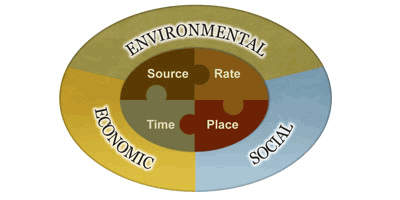
by Sheila Dunning | Jun 17, 2014
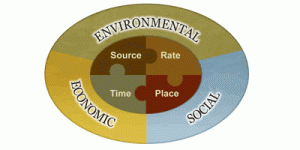 The old cliché is “April showers bring May flowers”, but April deluges create weak plants and yellow grass. You were following the UF/IFAS recommendations and waited until April 15th to fertilize. You followed the Urban Turf Rule and applied a low-phosphate fertilizer with slow-release nitrogen. Yet, your grass is yellow and the shrubs haven’t put on any new growth. What happened? The 18” + of rainfall that we experienced at the end of April flushed nearly everything out of the soil, including any fertilizer you applied. Nitrogen and potassium are highly leachable. Phosphorus is also depleted under saturated soil conditions.
The old cliché is “April showers bring May flowers”, but April deluges create weak plants and yellow grass. You were following the UF/IFAS recommendations and waited until April 15th to fertilize. You followed the Urban Turf Rule and applied a low-phosphate fertilizer with slow-release nitrogen. Yet, your grass is yellow and the shrubs haven’t put on any new growth. What happened? The 18” + of rainfall that we experienced at the end of April flushed nearly everything out of the soil, including any fertilizer you applied. Nitrogen and potassium are highly leachable. Phosphorus is also depleted under saturated soil conditions.
If you haven’t submitted a soil test since the storm, now is the time to do so. It’s time to apply a summer fertilizer, but it needs to address all the nutrient deficiencies created from the excess rain. Soil test kits can be obtained from your County Extension office. When you get the results from the University of Florida Lab, it is important to remember the 4 Rs when applying fertilizer. It needs to be the Right Source, applied at the Right Rate, at the Right Time, and over the Right Place.
Best Management Practices (BMPs) have been developed to allow individuals to make conscientious decisions regarding fertilizer selection that will reduce the risk of water contamination. The Right Source for a BMP-compliant fertilizer is one that contains a portion of slow-release (water insoluble) nitrogen with little to no phosphorus, and a potassium level similar to the nitrogen percentage (e.g. 15-0-15, that contains 5% coated nitrogen). However, a soil test is the only way to accurately identify the specific nutrients your landscape is lacking. Many soil tests indicate a need for phosphate and currently it is illegal to apply more than 0.25 pounds per 1,000 sq. ft. without a soil test verifying the need.
Next, the fertilizer must be applied at the Right Rate. In order to do that, you must know the square footage of your property and how much you can spread using the settings on your equipment. Individuals walk at varied speeds and the product recommended rates are based on 1,000 sq.ft. areas. For information on calibrating application equipment refer to 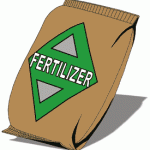 the publication, “How to Calibrate Your Fertilizer Spreader”. Using the 15-0-15 fertilizer mentioned earlier, the Right Rate for one application would be 3 pounds per 1,000 sq.ft.. That 35 pound bag is all that is needed for a nearly 12,000 sq.ft. yard (a large corner lot).
the publication, “How to Calibrate Your Fertilizer Spreader”. Using the 15-0-15 fertilizer mentioned earlier, the Right Rate for one application would be 3 pounds per 1,000 sq.ft.. That 35 pound bag is all that is needed for a nearly 12,000 sq.ft. yard (a large corner lot).
The Right Time for applying fertilizer is when the plants are actively growing and beginning to show nutrient deficiencies. Summer, when rainfall and irrigation is frequent, is often a typical application time. The Right Place is only on living plant areas. Be cautious to avoid getting fertilizer on the sidewalk, driveway and street. A deflector on your spreader is very helpful. Otherwise, be sure to sweep or blow the fertilizer back onto the grass or into the landscape beds. Avoid having fertilizer end up in any water body.
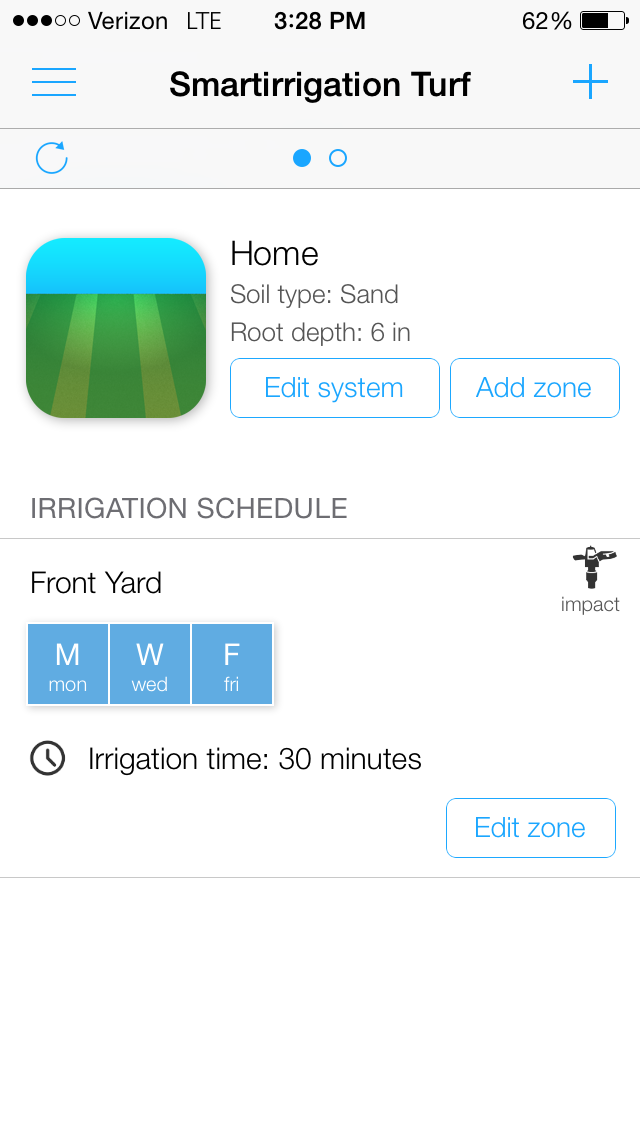
by Blake Thaxton | Jun 10, 2014
In this age of tablets, smart phones, and whatever they come up with next, even the gardener can benefit from new technology. Although gardening and landscaping to beautify our surroundings is a way to connect with the past, there are many new tools that are ready to help! Here are a few web sites and phone apps that may prove useful to the gardener.
Sod Solutions has made it easy to know how much sod you need to order by using a mapping system to create overlays that measure square footage. Measuring square footage can prove tough for irregularly shaped beds or turf lawns. This website can help measure accurately so one can also apply the correct amount of herbicides, pesticide, or fertilizer. The website can be difficult for the technology challenged among us. An easy solution is to find anyone under the age of 15 and they should be able to help!
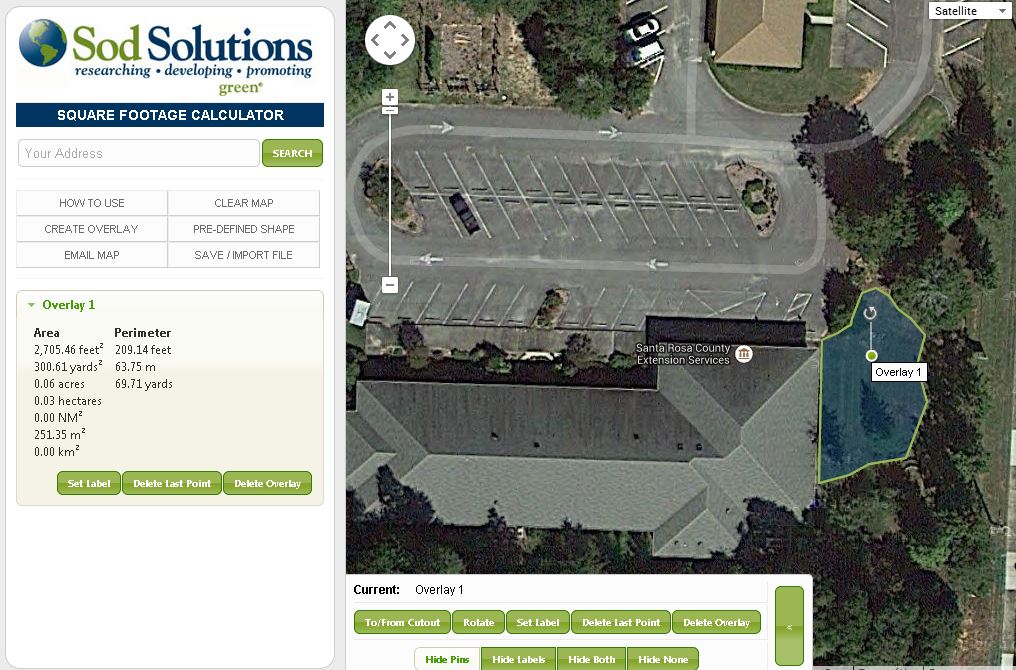
The Smartirrigation Turf app is designed to help homeowners with automatic irrigation systems in scheduling their watering times correctly. This app takes everything into account from soil type to local weather conditions. For example, you set a watering schedule for Zone X of 15 minutes every Monday, Wednesday, and Friday. Then, it does not rain for an extended period of time. Because your lawn does not get the supplemental rain that was predicted, the app may tell the home owner to change the setting to 25 minutes. To read more about using the app correctly, click on the link above.
Other apps that might prove useful are:
- NCSU Lawn Care App – An App by North Carolina State University all about lawn care.
- SoilWeb for Iphone – Produced by The California Soil Resource Lab that will tell you what kind of soil you are standing on.
- Leaf Snap – Developed by Columbia University, University of Maryland, and Smithonian Institution. The app uses visual recognition software to identify plants by taking pictures of its leaves.














